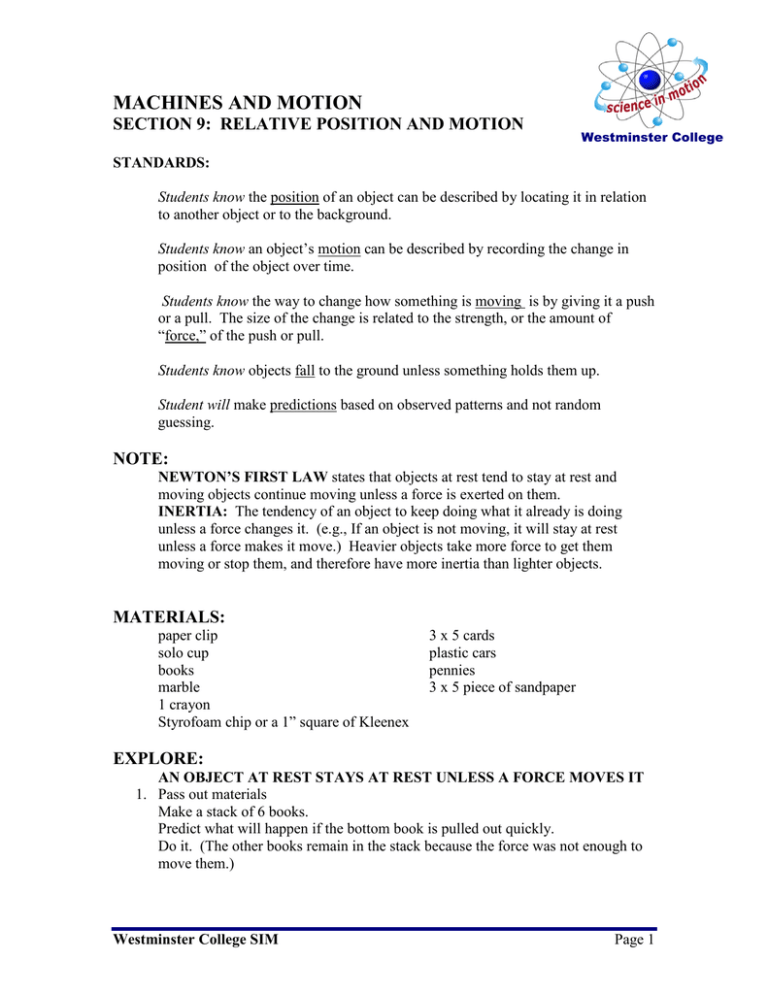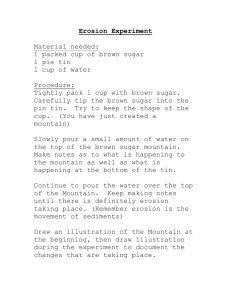MACHINES AND MOTION SECTION 9: RELATIVE POSITION AND MOTION
advertisement

MACHINES AND MOTION SECTION 9: RELATIVE POSITION AND MOTION Westminster College STANDARDS: Students know the position of an object can be described by locating it in relation to another object or to the background. Students know an object’s motion can be described by recording the change in position of the object over time. Students know the way to change how something is moving is by giving it a push or a pull. The size of the change is related to the strength, or the amount of “force,” of the push or pull. Students know objects fall to the ground unless something holds them up. Student will make predictions based on observed patterns and not random guessing. NOTE: NEWTON’S FIRST LAW states that objects at rest tend to stay at rest and moving objects continue moving unless a force is exerted on them. INERTIA: The tendency of an object to keep doing what it already is doing unless a force changes it. (e.g., If an object is not moving, it will stay at rest unless a force makes it move.) Heavier objects take more force to get them moving or stop them, and therefore have more inertia than lighter objects. MATERIALS: paper clip solo cup books marble 1 crayon Styrofoam chip or a 1” square of Kleenex 3 x 5 cards plastic cars pennies 3 x 5 piece of sandpaper EXPLORE: AN OBJECT AT REST STAYS AT REST UNLESS A FORCE MOVES IT 1. Pass out materials Make a stack of 6 books. Predict what will happen if the bottom book is pulled out quickly. Do it. (The other books remain in the stack because the force was not enough to move them.) Westminster College SIM Page 1 RELATIVE POSITION AND MOTION 2. DESCRIBE: Place the card on a cup with a penny or paper clip on top. Have the students write where each object is: Where is the penny? (on top of the card, above the cup) Where is the cup? (under the card, on the table.) 3. PREDICT: What will happen if the card is moved? 4. EXPERIMENT: Pull the card quickly across the cup (or flick it with a finger) What happens? (penny falls in cup) Pull the card slowly across the cup. What happens? Do the experiment again using a marble from the kits, a stack of coins, or other small objects. 5. LIGHTER OBJECTS FEEL YOUR FORCE What will happen if you put a light object on the card? Predict. Put a Styrofoam chip, small piece of Kleenex, or other very light object on the card. Experiment. Observe what happens. (The Kleenex ® feels the force and moves with the card.) 6. FRICTION: What would happen if you used sandpaper instead of the card? Try different objects on the rough side of the sandpaper. Try pulling the sandpaper fast. Pull it slow. What happens? (Sandpaper creates more friction, a force that slows the motion between objects. The objects have time to feel the force you give the paper and therefore move with it.) 7. DISCUSS: Which objects feel the force and move? (lighter objects) What is the force that causes objects to fall to the ground? (gravity) What would happen if you tried this in space? Would the objects stay on the card? (They would float without gravity.) EXPLORE: MOVING OBJECTS KEEP MOVING UNLESS A FORCE STOPS THEM 1. PREDICT: What would happen to a ball in the back of a truck if the truck suddenly stops? If the truck backs up? If the truck accelerates from a stopped position? EXPERIMENT: Test your ideas using a book with a crayon on top. 2. DEMONSTRATE: Use the plastic ‘magnet’ car in the kit (without the magnet). Tape a 3 x 5 card on the car to make a flat surface. Westminster College SIM Page 2 RELATIVE POSITION AND MOTION Put a marble on the middle of the card. Have the students predict where the marble will be if the car suddenly starts moving. Have the students write or draw to show their prediction. Give the car a push. Observe and discuss. While the car is moving, have the students predict what will happen to the marble if the car suddenly stops. Do it. Discuss results. 3. Why are seatbelts important? What happens to you when the driver slams on the brakes? (You are an object in motion that continues in motion unless a seatbelt stops you.) MATERIALS: The Tablecloth Trick: A plastic glass, plastic plate, cloth napkin, silverware, piece of fabric (2’ x 3’) or bandana to use for a tablecloth. Egg and Broom: jar, pie tin, broom, hard boiled egg, toilet paper cardboard roll ASSESSMENT 1: WHICH OBJECTS WILL FEEL THE FORCE? THE ‘TABLECLOTH TRICK’ Pass out the worksheet, Dishes on the tablecloth Place a glass of water, plastic plate, napkin and fork on a scarf, bandana or piece of fabric. ( A tablecloth has hem that might affect the experiment.) Have students: Predict what will happen if you pull the cloth fast. Predict what will happen if you pull the cloth slow. Demonstrate and have students complete the worksheet. WORKSHEET ANSWERS: ‘Tablecloth Trick’ 1. Heavier objects, 2. Gravity, 3. Weight (or mass), 4. Feel the force- pulled off the table, 5. Friction ASSESSMENT 2: EGG AND BROOM: Pass out the worksheet Egg Over Water. Put 1 hard boiled egg or a ball on a toilet paper roll in a pie tin. Put the pie tin on a plastic jar of water. The egg must be centered over the jar of water. The pie tin should hang over the edge of the table slightly. Have the students draw and describe the position of the objects on their worksheet. Predict which objects will stay in place if the pie tin is hit hard. EXPERIMENT: Westminster College SIM Page 3 RELATIVE POSITION AND MOTION Hold the broom firmly against the table with your hip. Pull back on the stick. Release quickly to hit the pie tin hard with the broomstick. [The force is big enough to move the pie tin and TP roll. The egg stays in place as it has more weight (mass) and thus the force is not enough to move it.] Why does the egg end up in the water? (gravity) What would happen if the pan had a lot of friction? (The TP roll might stay on the pie tin long enough for the force to affect the egg.) Have students complete the work sheet. Westminster College SIM Page 4 RELATIVE POSITION AND MOTION Westminster College SIM Page 5 RELATIVE POSITION AND MOTION Westminster College SIM Page 6



